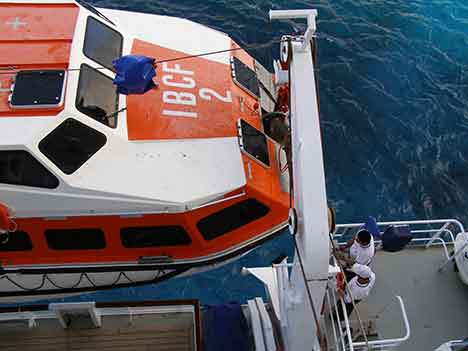Lifeboats and Liferafts on Cruise Ships
A topic of concern for many first-time cruisers is the issue about the number of lifeboats on a cruise ship and whether there are enough spaces in the lifeboats and liferafts to accommodate everyone on board..

Photo: Lifeboat being launched
The story of the Titanic is still fresh in everyone’s minds.
The good news is that the International Convention for the Safety of Life at Sea (SOLAS) is an international maritime safety treaty that specifies minimum standards for the construction, equipment and operation of ships.
Originally a response in 1914 to the sinking of the Titanic, this international treaty covers all vessels, including cruise ships, traveling in international waters.
This treaty stipulates that all cruise ships must have a lifeboat and life-raft capacity that exceeds the total number of the people on board.
Furthermore, the treaty states that each side of the ship must carry enough enclosed power driven lifeboats to handle over 50% of the total number of the people on board and AND each side of the ship must carry inflatable liferafts to to handle over 50% of the total number of the people on board.
This means that even if the ship is listing to one side so as to make the lifeboats inaccessible, or the deck in question is unavailable for any other reason, the cruise ship will still enough lifeboats and liferafts to accommodate the whole ship.
To further ensure the safety of cruise passengers, The International Life-Saving Appliance Code (LSA) requires certain emergency equipment be carried on each lifeboat and life-raft used on international voyages.
Modern lifeboats today must carry an Emergency Position-Indicating Radio Beacon (EPIRB) and either a radar reflector or Search and Rescue Transponder (SART).
The difference between Lifeboats and Liferafts on Cruise Ships
Modern lifeboats have a motor and use a davit or launching system, whereas Liferafts usually do not have a motor and re stored in a collapsed format in a heavy-duty fiberglass canisters on deck.
The disadvantage of lifeboats is that launching may take longer than the liferafts. The disadvantage of liferafts is that they may not be as efficient because of inflation system failures.
For those looking for more information about a particular cruise ship, contact the cruise line directly. They are required to answer your questions about the lifeboat and liferaft situation onboard.
